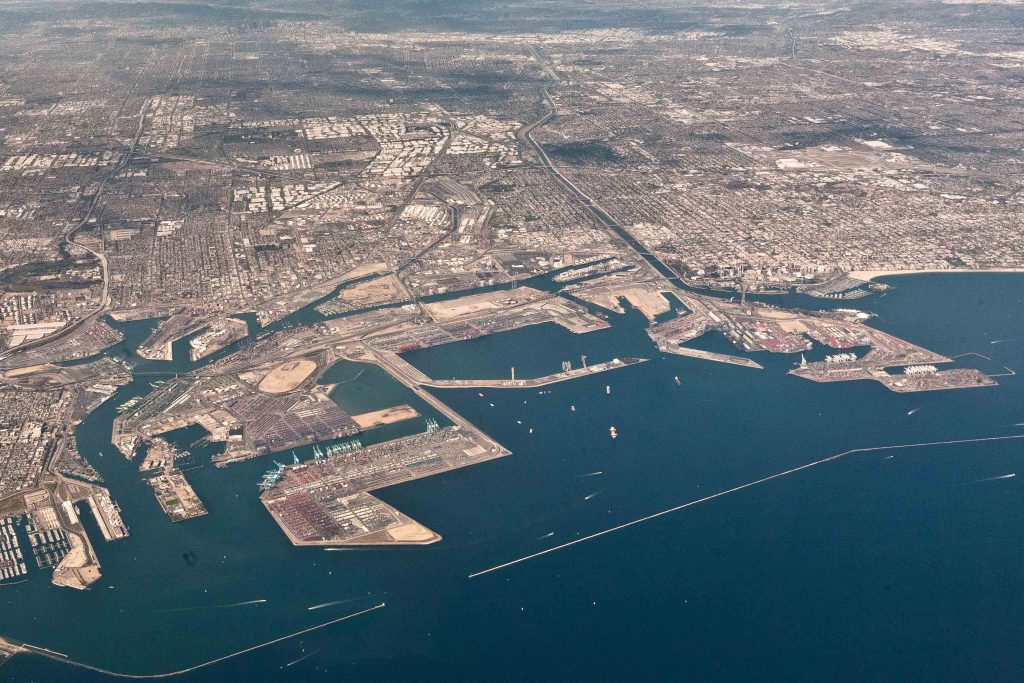Deprecated: Function utf8_decode() is deprecated in /nas/content/live/gorailorg/wp-content/plugins/inline-tweet-sharer/inc/display.php on line 88
Long Beach, Calif. — This spring, ports around the U.S. will start welcoming new and larger vessel services, and the Port of Long Beach will be handling the biggest ships to call North America.
Behind the shift is a recent set of mergers between ocean carriers – and the consequent consolidation of shipping alliances between these carriers. It not only means bigger ships, but also major downstream consequences for ports, railroads and other parts of the logistics network.
We spoke with Dr. Noel Hacegaba, chief commercial and operations officer at the Port of Long Beach (POLB), about the shift in alliances, and what it will mean for the port and its rail connections.
 Question: How are changing shipping alliances affecting POLB?
Question: How are changing shipping alliances affecting POLB?
Dr. Hacegaba: We have spent the past six months closely monitoring the formation of the new alliances, all in an effort to understand the potential impacts to terminal utilization and operations. As soon as we received the new service schedule that revealed where these alliances would be sending their services, it put us in a position to be able to work with our industry partners to make sure that everyone was talking to one another and sharing the information necessary to make real-time, reliable decisions – and mitigate any disruptions to service. We have spent the last several months assessing readiness and connecting the different supply chain partners to ensure a seamless transition to the new alliance structure.
Question: Why do bigger ships mean consolidation of shipping alliances?
Dr. Hacegaba: Vessel sharing agreements have been around for decades and what they do is allow the shipping lines to optimize their respective vessels – no different than the airlines, which have Oneworld alliance and Star Alliance, for example. It’s all in an effort to optimize capacity and maximize economies of scale. Vessel sharing agreements attempt to do the same, especially now that vessels have nearly tripled in size in the past decade. The difference between the alliances of years past and the today’s ocean carrier alliances is in the sheer scale and capacity. Three new shipping alliances will handle 94 percent of the trans-Pacific market.
As a result of the massive realignment in the shipping industry over the past 30 months, the global roster of shipping lines has dwindled from 20 to 13 and the largest ocean carriers have concentrated into three major alliances, and much of this was triggered by the rapid increase in vessel capacity. So, just to give you an idea, in a period of 10 years, the largest size vessel to regularly call San Pedro Bay has grown from 4,000 TEU [twenty-foot equivalent unit, a measurement for shipping containers] to 14,000 TEU. And, last year, we welcomed the first 18,000 TEU vessel to the Port of Long Beach. All that additional capacity, by virtue of the upsizing of ships, has resulted in the formation of larger alliances, so that the shipping lines could optimize slots aboard their vessels and maximize economies of scale.
Question: How much does POLB currently use rail?
Dr. Hacegaba: Today, about two-thirds of all cargo that crosses our gateway eventually makes its way into the interior of the United States via rail. Some of the cargo that arrives to our port goes on rail immediately, that’s what we call on-dock rail, and other cargo leaves the port on a truck, but it ends up in a nearby rail yard and then it makes its way to the interior of the U.S. via rail. So, when you add up all that cargo, we’re talking about two-thirds of our total cargo. That is why the Southern California gateway is known as an intermodal gateway, and it’s an important part of our value proposition because it offers superior transit times to our customers.
Question: In terms of rail, what is POLB doing to prepare for the new ocean alliances?
Dr. Hacegaba: Right now, our focus is on expanding our on-dock rail capabilities. We believe that on-dock rail is both more efficient and more sustainable. Today, approximately 28 percent of all of our cargo is on-dock, which means that it leaves the terminal on rail. We have plans to aggressively grow the percentage of on-dock rail. Over time, we would like to see more than half of all of our cargo leave our port on rail.
To offer some context, the latest long-term cargo forecast for San Pedro Bay puts us at 40 million container units by 2040. Last year, the Ports of Los Angeles and Long Beach combined handled 15.5 million TEU. So, we expect to see our annual through-put more than double within the next 24 years, which is why shifting more of our container movements to rail makes a lot of sense.
We’re in close communication with the railroads – the two Class I’s, Union Pacific and BNSF – to make sure they are receiving the information they need to plan their equipment accordingly. We understand that when it comes to rail, preparation is key, and balance is also important. So, we’re working closely with the railroads and the shipping lines to make sure that they’re communicating and the railroads have the information necessary to plan and optimize their operations here in our complex.

Question: The rail industry recently released a report on the relationship between international trade and rail. For example, 42% of rail carloads and intermodal units are directly associated with international trade. Could you talk about trade’s relationship with POLB?
Dr. Hacegaba: The southern California gateway is heavily reliant on trans-Pacific trade – China being our largest partner, followed by South Korea and Japan. Well over 80 percent of our cargo comes from Asia, so Asia is a very important partner. The trade activity at the Port of Long Beach generates one out of eight jobs for the city, 300,000 jobs in southern California, and more than 1.5 million jobs across the country. In fact, the cargo that crosses our gateway reaches every single U.S. congressional district.
Trade has a very positive and significant effect on the U.S. economy. Cargo is the U.S. economy in motion. That is why the Port of Long Beach is aggressively investing in infrastructure. We’re investing $4 billion to modernize our facilities and upgrade our infrastructure, and also strengthen our rail system and increase our rail capacity. That’s $4 billion we’re investing in our future. And that’s all in an effort to build on our value proposition. Again, we are an intermodal gateway. Rail is key to our success because it is vital to keeping the Southern California gateway competitive.

